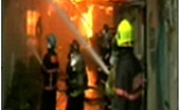The firefighters in Daegu city had participated the subway fire disaster that took 340 casualities at 2003, are still experiencing posttraumatic stress. The purpose of this study was to identify the subjective types and structures of the posttraumatic...
http://chineseinput.net/에서 pinyin(병음)방식으로 중국어를 변환할 수 있습니다.
변환된 중국어를 복사하여 사용하시면 됩니다.
- 中文 을 입력하시려면 zhongwen을 입력하시고 space를누르시면됩니다.
- 北京 을 입력하시려면 beijing을 입력하시고 space를 누르시면 됩니다.

대구지하철 참사 경험 소방관의 외상 후 스트레스 = Posttraumatic Stress in Firefighters - Daegu Subway Fire Disaster
한글로보기https://www.riss.kr/link?id=A104100489
-
저자
백미례 (충추대학교)
- 발행기관
- 학술지명
- 권호사항
-
발행연도
2007
-
작성언어
Korean
-
주제어
Posttraumatic Stress ; Firefighter ; Subjectivity ; 외상 후 스트레스 ; 소방관 ; 주관성연구
-
등재정보
KCI등재후보
-
자료형태
학술저널
-
수록면
109-128(20쪽)
-
KCI 피인용횟수
7
- 제공처
-
0
상세조회 -
0
다운로드
부가정보
다국어 초록 (Multilingual Abstract)
(3)Trauma experience persistence have a trauma experience persistence state that they keep reexperiencing, avoidance and hyperarousal symptoms, This type of firefighter have experienced the most severe posttraumatic stress symptom. Q-block is developed as a assessment tool for large size sample. Q-block contains Q1, Q2, Q3 questionnaire. The Q1-block contains My feeling with regard to the disaster is insensitivity. It seems that my feeling with regard to the disaster is insensitivity as time goes on. The stress has disappeared a little bit when I talked about the disaster. The Q2-block contains I have suffered from the muscular pain or migraine and always been tired after the disaster. It seems that the power of memory and concentration impaired gradually after the disaster. I have frequently suffered from bronchial symptoms and a cold sweat. The Q3-block contains I have tried to avoiding the situation and event that remind me of the disaster. I have been painful when the memory related to the disaster came across my mind suddenly without intent. I have avoided to tell about the disaster because family and friends should be worried about my job, a firefighter. 3 types were distributed into Emotional arousal trauma(52.4%), Trauma experience persistence(34.1%) and Physiological symptom experience(13.5%). Base on the result of this research, this study is showed that firefighters had experienced not only a reexperience of the accident, avoidance and increased hyperarousal symptoms by the diagnosis criteria of American Psychological Association, but also partial posttraumatic stress symptoms of various levels. The need for an institutional system is proposed to decrease posttraumatic stress and to cope with it appropriately through pattern analysis Also this study can help supply crucial data for the development of intervention program for whom suffer posttraumatic stress by firefighters through understanding subjectivity of posttraumatic stress.
The firefighters in Daegu city had participated the subway fire disaster that took 340 casualities at 2003, are still experiencing posttraumatic stress. The purpose of this study was to identify the subjective types and structures of the posttraumatic stress in firefighters who experienced the Daegu subway fire disaster, to develop the Q-block as a assessment tool for types and to identity how types are actually existed in the firefighters. This study used Q-methodology that has been conducted by selecting the 44 statements as a Q sample finally. The analysis identified 3 types of posttraumatic stress :Emotional arousal trauma, Physiological symptom experience, trauma experience persistence.:(1)Emotional arousal trauma have a more mild symptom because they'd endeavored to decrease their stress by an active approach. But increased arousal reactions have been experienced continuously. (2)Physiological symptom experience have a physiological symptom brought by anxiety and strain from not managing the stress.
(3)Trauma experience persistence have a trauma experience persistence state that they keep reexperiencing, avoidance and hyperarousal symptoms, This type of firefighter have experienced the most severe posttraumatic stress symptom. Q-block is developed as a assessment tool for large size sample. Q-block contains Q1, Q2, Q3 questionnaire. The Q1-block contains My feeling with regard to the disaster is insensitivity. It seems that my feeling with regard to the disaster is insensitivity as time goes on. The stress has disappeared a little bit when I talked about the disaster. The Q2-block contains I have suffered from the muscular pain or migraine and always been tired after the disaster. It seems that the power of memory and concentration impaired gradually after the disaster. I have frequently suffered from bronchial symptoms and a cold sweat. The Q3-block contains I have tried to avoiding the situation and event that remind me of the disaster. I have been painful when the memory related to the disaster came across my mind suddenly without intent. I have avoided to tell about the disaster because family and friends should be worried about my job, a firefighter. 3 types were distributed into Emotional arousal trauma(52.4%), Trauma experience persistence(34.1%) and Physiological symptom experience(13.5%). Base on the result of this research, this study is showed that firefighters had experienced not only a reexperience of the accident, avoidance and increased hyperarousal symptoms by the diagnosis criteria of American Psychological Association, but also partial posttraumatic stress symptoms of various levels. The need for an institutional system is proposed to decrease posttraumatic stress and to cope with it appropriately through pattern analysis Also this study can help supply crucial data for the development of intervention program for whom suffer posttraumatic stress by firefighters through understanding subjectivity of posttraumatic stress.
참고문헌 (Reference)
1 "최신정신의학" 일조각 1999
2 "재난과 정신건강" 대한 불안장애학회
3 "응급구조사의 스트레스와 대처방법과의 관계연구" 2002
4 "소방행정자료 및 통계" 행정자치부 소방행정과
5 "소방대원의 출동충격스트레스에 관한 구조모형" 2000
6 "소방대원의 외상성 스트레스에 관한 연구" 2002
7 "소방대원의 스트레스 정신건강에 관한 연구" 113-125,
8 "소방관 직무에 관련된 질환과 건강관리" 27-34,
9 "소방공무원 안전사고 원인분석 및 대책 : 스트레스성 질병 및 사고 중심" 중앙소방학교 우수과제선집 3-123, 1998
10 "coping with PTSD and recomanded lifestyle changes for PTSD patients A national center for PTSD fact shet"
1 "최신정신의학" 일조각 1999
2 "재난과 정신건강" 대한 불안장애학회
3 "응급구조사의 스트레스와 대처방법과의 관계연구" 2002
4 "소방행정자료 및 통계" 행정자치부 소방행정과
5 "소방대원의 출동충격스트레스에 관한 구조모형" 2000
6 "소방대원의 외상성 스트레스에 관한 연구" 2002
7 "소방대원의 스트레스 정신건강에 관한 연구" 113-125,
8 "소방관 직무에 관련된 질환과 건강관리" 27-34,
9 "소방공무원 안전사고 원인분석 및 대책 : 스트레스성 질병 및 사고 중심" 중앙소방학교 우수과제선집 3-123, 1998
10 "coping with PTSD and recomanded lifestyle changes for PTSD patients A national center for PTSD fact shet"
11 "Voting behavier in schol referenda An investigation of atitutes and other determinants by Q technique and survey research" Kent State University 1971
12 "Twenty-four-hour ambulatory assesment of heart rate and chronic PTSD and non-PTSD veterans" 17 (17): 163-171, 2004
13 "Traumatic stres & organizational strain in the fire service. Job stress interventions" Washington. DC :APA Pres 185-198, 1995
14 "The study of behavior; Q-technique and its methodology" 1953
15 "The stres upon rescuers involved in an oil rig diaster" 1989
16 "The psychological impact of disaster on rescue personel" 664-668, 1985
17 "The isue of psychological scars and the occurence of PTSD symptoms" 107-109,
18 "The Q block method of indexing Q typologies" 1963
19 "Q방법론의 이해와 활용" 공주대학교 건강산업연구소 2003
20 "Primary care treatment of post-traumatic stress disorder" 1035-1046,
21 "Postraumatic stress in volunter firefighters Predictors of distres The Journal of Nervous and Mental Disease" 267-271,
22 "Merger of Questionare and Q- sort techniques" North Carolina University 1976
23 "Longitudinal course and predictors of continuing distres folowing critical incident exposure in emergency services personnel" 187 (187): 15-2, 1999
24 "Journal of Emergency Medical Services" 52-54, 1984
25 "Ideology in africa" 1975
26 "Firefighter fetality retrospective study" 23-, 2002
27 "Diagnostic 126 주관성 연구 제14호 2007년 6월and Statistical Manual for Mental Disorders"
동일학술지(권/호) 다른 논문
-
- 한국주관성연구학회
- 구미향
- 2007
- KCI등재후보
-
우연, 강박, 방법론적 습성과 긴장 :과학적 발견의 추동력
- 한국주관성연구학회
- 김웅진
- 2007
- KCI등재후보
-
한국 언론인의 국익에 관한 인식유형 연구 :Q-방법론의 적용
- 한국주관성연구학회
- 이장한
- 2007
- KCI등재후보
-
- 한국주관성연구학회
- 김흥규
- 2007
- KCI등재후보
분석정보
인용정보 인용지수 설명보기
학술지 이력
| 연월일 | 이력구분 | 이력상세 | 등재구분 |
|---|---|---|---|
| 2022 | 평가예정 | 재인증평가 신청대상 (재인증) | |
| 2019-01-01 | 평가 | 등재학술지 유지 (계속평가) |  |
| 2016-01-01 | 평가 | 등재학술지 유지 (계속평가) |  |
| 2012-01-01 | 평가 | 등재 1차 FAIL (등재유지) |  |
| 2009-01-01 | 평가 | 등재학술지 선정 (등재후보2차) |  |
| 2008-01-01 | 평가 | 등재후보 1차 PASS (등재후보1차) |  |
| 2006-01-01 | 평가 | 등재후보학술지 선정 (신규평가) |  |
학술지 인용정보
| 기준연도 | WOS-KCI 통합IF(2년) | KCIF(2년) | KCIF(3년) |
|---|---|---|---|
| 2016 | 0.93 | 0.93 | 1.06 |
| KCIF(4년) | KCIF(5년) | 중심성지수(3년) | 즉시성지수 |
| 1.08 | 0.95 | 1.391 | 0.06 |




 KCI
KCI




